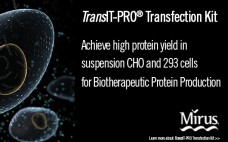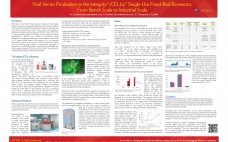Recombinant protein–based medicinal products and modern cell-based vaccines have a very strong safety history with respect to viral and microbial contamination. However, virus contamination incidents do occur occasionally in manufacturing processes, and they can consume many resources and be expensive to rectify. The root cause of contamination incidents in recent years is most likely the use of contaminated raw materials. These include bovine serum contaminated with reovirus, epizootic hemorrhagic disease virus, Cache valley virus or vesivirus 2117; porcine trypsin contaminated…
Upstream Processing
Development Strategies for Novel Vaccines for Infectious Diseases
In a vaccine development program, the probability of success at each transition decreases, even though the actual probability of moving from one phase to another can be 50–80% (Figure 1). Many compounds and vaccine candidates are screened out even before they get into preclinical studies. Developers can implement different approaches to reduce product failure risk before a program gets expensive, including Establishing a product development plan (PDP) Identifying and mitigating risk with gap analysis Learning from the mistakes of others…
Simpler and More Efficient Viral Vaccine Manufacturing
Human and veterinary vaccines are divided into five main categories: conjugate, toxoid, subunit, inactivated (killed), and live (attenuated) vaccines (1). The vast majority of currently licensed human and veterinary vaccines are inactivated or live (2, 3). They are produced mostly using adherent cells: primary cells such as chicken embryo fibroblasts (CEF), human diploid cells such as MRC-5, or continuous cell lines such as Vero and MDCK (4). The pioneering legacy inherited by vaccine manufacturing development has led to strategies for…
Inactivated Poliovirus Vaccine Made in Modular Facilities with Single-Use Technology
If current efforts to eradicate polioviruses worldwide are successful, then the oral poliovirus vaccine (OPV) currently used for routine immunization in low- and middle-income countries (LMICs) will be replaced by inactivated poliovirus vaccine (IPV). IPV will become the only option for such countries if they want to continue to vaccinate against polio (1). Because IPV is currently considered to be too expensive for use in LMICs, strategies are being undertaken to make IPV more affordable (2). Some experts estimate that…
Development of Protein Capsular Matrix Vaccine Platform Technology
Polysaccharide vaccines account for about 30% of the total >$20-billion/year vaccine market. Despite efficacious vaccines in the field, diseases such as invasive Streptococcus pneumoniae and typhoid fever persist. Development of multivalent polysaccharide conjugate vaccines requires complex chemistries and multiple, expensive good manufacturing practice (GMP) process steps. Matrivax Research and Development Corporation is developing a protein capsular matrix vaccine (PCMV) technology that simplifies synthesis of polysaccharide vaccines with fewer process steps than are required by typical conjugation vaccine processes. Polysaccharide Vaccine…
Emerging Challenges to Protein A
Protein A affinity chromatography has been a target for replacement since its commercial debut, mainly because of its high acquisition cost. The technique became established despite the cost because it was born into an industrial culture that favored speed to market over manufacturing economy (1). Vendors have since strengthened protein A’s position with incremental but worthy improvements such as higher capacity, lower ligand leaching, and modest tolerance of NaOH. Collateral improvements in polishing technologies, such as the high throughput and…
Validation of the New Single-Use Freeze-Pakâ„¢STS Storage and Transport Solution Containers
Production of biotherapeutics whether for clinical development or large scale manufacturing campaigns intended to be converted to final drug product often involves frozen storage. Frozen storage provides manufacturing process flexibility while enabling long-term product stability. Products are frozen and stored using a variety of technologies including stainless steel vessels, bottles, carboys and single-use bags. Use of bags has become popular due to their low investment cost and process flexibility attributes. Single-use bags intended for freezing and storage are often made with films using EVA and/or LDPE with product routinely blast frozen and stored to -30°C in a cold storage warehouse. During freezing and transport, the bags will typically experience temperatures well below -30°C ranging from -50 to -80°C. Under these conditions, the bags have to endure a wide variety of stresses (film brittleness, volume expansion, etc.) impacting integrity. With applications (like working cell banks for example) requiring lower temperatures for maintenance of long-term product stability, frozen storage films and containers designed for these conditions are needed. The new single-use Freeze-Pak™STS (FP-STS) frozen storage and transport solution containers from Charter Medical, Ltd. are manufactured using a unique polyolefin monolayer film designed for freezing applications The FP-STS bags (including tubing and connectors) have been validated for storage to -80°C, while the Freeze-Pak™ film remains flexible to temperatures as low as -196°C. The new Freeze-Pak™ STS bags deliver the flexibility and durability required for frozen storage and transport.
E. coli Cultivation in a 12L and 120L CELL-tainerâ„¢ Single-Use Bioreactor
Single-use bioreactors are usually applied in the biopharmaceutical industry for mammalian cell culture processes. For microbial processes, concepts like the CELL-tainer® technology allow comparable gas-liquid mass transfer rates like in stirred tank reactors. In the CELL-tainer, the rocking motion of the bag is generated with a combination of a vertical and horizontal movement. Due to a 2-D rocking motion, the turbulence in the liquid is intensified. Thus, volumetric oxygen transfer rates (kLa) of over 400 h-1 could be achieved. Recently, the successful scale-up of an Escherichia coli nutrient-limited fed-batch cultivation from the 15 L to the 150 L scale in the CELL-tainer single-use bioreactor has been conducted. A final biomass concentration of 45 gL-1 within 24 hrs was obtained in cultivations proving the general suitability of this reactor concept for the application of bacterial processes. The combination of intelligent software sensor control strategies and currently improving (single-use) sensors will lead to a reduction of current drawbacks and improve control of bacterial fed-batch processes. The availability of single-use bioreactors for microbial cultivations widens their potential, not only in biopharmaceutical processing, but also as a pre-culture bioreactor for large scale processes and as a suitable tool in bioprocess development.
Selecting a Transfection Reagent for Large Scale Protein Production in Suspension 293 Cell Types
Decrease time to produce usable protein by maximizing target protein yields through transient transfection. The TransIT-PRO® Transfection Kit uses animal origin free components designed for high and reproducible nucleic acid delivery into suspension CHO and 293 derived cells. Since it is compatible with varied media formulations, the same media can be used for both transient and stable expression. The TransIT-PRO outperforms linear PEI in protein yield, while providing a cost-effective alternative to FreeStyle™ MAX and 293Fectin™ Transfection Reagents.
Viral Vector Production in the Integrity® iCELLis® Disposable Fixed-bed Bioreactor from Bench-scale to Industrial Scale
Recombinant viruses (e.g. lentivirus and adeno-associated-virus) can be used as human gene therapy vectors. They are mainly produced in adherent cell cultures (e.g. HEK293T, A549, VERO) in Roller Bottles or multiple-tray-stacks using either transient transfection or infection strategies. Therefore, the Integrity® iCELLis® (ATMI LifeSciences) line of bioreactors offers a new production alternative with stronger process controls and ease of scale-up. The iCELLis bioreactor is designed for adherent cell culture applications. Cells grow on microfibers carriers packed in a fixed-bed…




